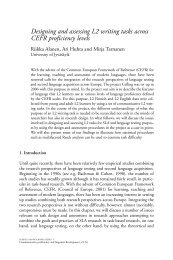BOOK OF ABSTRACTS - EUROSLA
BOOK OF ABSTRACTS - EUROSLA
BOOK OF ABSTRACTS - EUROSLA
Create successful ePaper yourself
Turn your PDF publications into a flip-book with our unique Google optimized e-Paper software.
Can speed and automatization of lexical access be used as measures of<br />
proficiency?<br />
Raquel Serrano<br />
Universitat de Barcelona<br />
Lexical decision tasks have often been used to examine second language<br />
learners’ speed (reaction time, RT) and automatization (coefficient of<br />
variation, CV) of lexical access in a second language (L2). Additionally,<br />
lexical access has been considered a measure of proficiency (Segalowitz &<br />
Frenkiel-Fishman, 2005) as well as an indicator of fluency (Segalowitz &<br />
Freed, 2004). Segalowitz and his colleagues suggest that participants’ RT<br />
and CV should be computed for their L2 but also for their L1 (first language)<br />
in order to determine a “specific L2 index”, which controls for individual<br />
differences in lexical access. The purpose of the present study is to examine<br />
L2 and L2-specific indexes and analyze how they correlate with other<br />
measures of proficiency (standardized placement test, vocabulary test, and<br />
oral fluency). Another goal of this study is to examine the effect of L1<br />
cognates in L2 lexical access, which is especially relevant since the bilingual<br />
cognition literature has shown that cognates are accessed faster than noncognates<br />
(Dijkstra et al., 2010).<br />
A total of 237 Spanish/Catalan bilinguals performed an animacy<br />
judgment task (based on the task used by Segalowitz & Freed, 2004), which<br />
included 200 words that the learners had to classify as ‘living’ or ‘non<br />
living’. Half of these words were in English (L2) and half in the participants’<br />
dominant language. The list of English words included 28 words that were<br />
cognates in Catalan and 24 in Spanish. A subgroup of these participants<br />
performed the other proficiency tests.<br />
The results of the analyses indicate that L2 and L2-specific RT and CV<br />
correlate with some measures of proficiency. Moreover, while cognates were<br />
accessed significantly faster than non-cognates, the mean RT and CV<br />
correlated equally with other proficiency measures in both cases. In<br />
conclusion, it can be claimed that the lexical access of cognates and noncognates<br />
is equally informative concerning L2 proficiency.<br />
Dijkstra, T., Miwa, K., Brummelhuis, B., Sappelli, M., & Baayen, H. (2010). How<br />
cross-language similarity and task demands affect cognate recognition. Journal<br />
of Memory and Language, 62, 284-301.<br />
Segalowitz, N., & Freed, B. F. (2004). Context, contact, and cognition in oral<br />
fluency acquisition: Learning Spanish in At Home and Study Abroad contexts.<br />
Studies in Second Language Acquisition, 26, 173-199.<br />
Segalowitz, N., & Frenkiel-Fishman, S. (2005). Attention control and ability level in<br />
a complex cognitive skill: Attention shifting and second-language proficiency.<br />
Memory & Cognition, 33, 644-653.<br />
29



